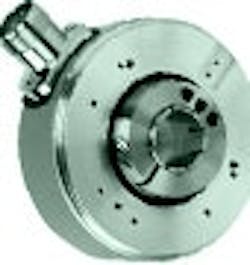Encoders and Resolvers Say More
Durability and flexibility are improving the feedback and communications capabilities of encoders and resolvers, while adding opportunities where the devices can be used in machine motion applications.
This device segment also is shifting from optical to magnetic technology as lower costs and more-compact designs make magnetic encoders a practical, more-rugged option for machine builders.
Greg Bova, motion business development manager at Baumer, says machine builders want better reliability and improved position integrity from encoders. “Magnetic sensing solutions provide an excellent value,” he says, describing the technology as extremely robust, reliable, compact in size, cost-effective and reasonably accurate.
Brian Winter, encoder product manager for Avtron Industrial Automation says the magnetic encoder traditionally has been the high-cost, low-resolution, heavy-duty cousin of its optical counterparts, but improvements have decreased cost, increased resolutions and introduced form factors that mimic or replace optical designs.
According to Winter, these improvements don’t interfere with the device’s ability to withstand shock, vibration, dust, dirt, liquids, and temperature changes—a big benefit compared to optical counterparts.
For large, multi-axis machines, for which operator safety is paramount, position integrity under all operating conditions and especially during off or failsafe operation, is critical, notes Bova. “Absolute encoders are the only digital devices that provide correct position feedback under all conditions,” he adds, noting that if a machine’s axis power fails, “the absolute encoder tells the controller immediately after power-up where the axis is located. When the axis was manually moved during power-off, the absolute encoder identifies its current location when power is restored.”
Thomas Wyatt, national sales and product manger in the automation division at Heidenhain says machine builders should know that some absolute encoders now are approved for applications at Safety Integrity Level 2, Category 3. These approved encoders provide two independent position values in digital form to satisfy redundancy requirements.
Winter notes that traditionally resolvers were used for high-temperature, extremely rough environments such as a hot metal caster or on Arctic oil-drilling rigs. “Encoder electronics have hugely expanded their durability and temperature range,” he says. “This means encoders now can be used in both high and low temperature extremes, where previously only a resolver would have survived.”
With motor-like construction and no built-in electronics, resolvers also were used for extremely dirty or wet applications, but now, notes Winter, magnetic encoders can operate fine in those conditions.
Resolver manufacturers are moving to hollow-shaft designs, away from shafted, coupled designs for which the coupling was the most unreliable part of the system, says Winter. “Hollow-shaft resolvers can be mounted directly on motor or machine shafts, eliminating the coupling and, in some cases, the bearings,” he adds. “This increases device reliability greatly.”
Resolver-based technology is another development contributing to durability and value-added reliability, especially in harsh environments, says Leo Brennan, sales manager for AMCI. "The advent of resolver-based technology enables customers to take advantage of output signals without worrying about the effects of shock and vibration that compromise the performance of optical and magnetic units," he says.
Customers use resolver-based encoders for position feedback on railroad track grinding heads, steel mill crane systems and subterranean mining car systems, he says.
Resolver characteristics permit cable runs up to 1,000 ft while an encoder is limited to 50 ft in some applications, says Brennan, who notes the wide acceptance of industrial networks has created new ways to communicate resolver information to programmable controllers, including both wired and wireless connections.
Joanna Suresh, encoders product specialist for Sick sees wireless communications and controls for encoders at the early stages of development with bandwidth issues being the main obstacle. But Suresh notes that absolute encoders can have a high level of communication using synchronous serial interface, CANopen, DeviceNet, Profibus, Hiperface and other interfaces.
Matthew Scott, director of operations and strategic development for TR Electronic/ZTR Control Systems, argues that the trend is to industrial Ethernet as an encoder communication standard. “This will change the way devices are used and replace proprietary cabling and connectors, providing more standardization of control systems and their components,” says Scott.
Phil Burgert is a freelance writer, specializing in the technical trade media.

